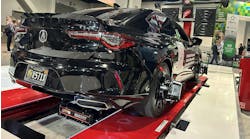You might be tempted to think that high performance (HP) and ultra-high performance (UHP) tire pressure monitoring system (TPMS) service is no different than standard TPMS service. If so, think again.
There are several TPMS-related concepts technicians should keep in mind when working with HP and UHP tires.
John Rice, director of TPMS products and support for 31 Inc., says low-profile HP and UHP tires “have shorter overall sidewall heights, which means scanning/activating/waking up TPMS sensors as part of the relearn (process) is more difficult.”
The reason? “Less sidewall to use for scanning. It is important to position the TPMS tool over the sidewall of the tire adjacent to the sensor and not directly over the sensor.”
Rice also notes that “clamp-in TPMS sensors have serviceable parts - nut, core, grommet and sometimes washers - that should be replaced anytime a tire is removed from the wheel,” which underscores the “importance of going through the sidewall of the tire.”
Leyla Saad, marketing coordinator for Schrader TPMS Solutions, says that HP and UHP tires that have been “installed on performance wheels might have a very different sensor and rim fitment compared to original equipment specifications and in some cases, it can make the sensor activation process difficult.
“Reverse mount, large off-set, 90-degree valve hole - these are all factors that might impact whether the sensor can be activated or scanned through the tire’s sidewall.
“For example, a sensor can be too far from the tool antenna and might not activate or the tool might not pick up sensor transmission.”
A review of the basics
“High performance wheels and tires require high performance TPMS service and parts,” says Scot Holloway, CEO of Bartec USA LLC. “Technicians will do well to consider these key points of service:”
Performing necessary system diagnostics
Installing the proper sensors
Making sure the vehicle is properly calibrated
Systems diagnostics should include a baseline inspection of TPMS sensors, as well as a read from the TPMS control module, according to Holloway.
“The technician is looking for any current fault codes,” including diagnostic trouble codes. “The rules state that the TPMS must remain operational. Using a TPMS diagnostic tool can help establish the condition of the TPMS.”
New tires and wheels “usually mean new TPMS sensors,” notes Holloway.
“When installing a new tire/wheel package, it is required that the vehicle’s TPMS remains operational. This means making sure you have the proper replacement sensor installed and a system relearn completed.”
Choosing the right sensor is based on function. “In high performance tire applications, it can also mean choosing a sensor that fits the look of the wheel and tire. Replacement sensors that offer painted or chrome stems further enhance the tire and wheel package.”
Holloway says aluminum clamping valve stems “are preferred” in HP applications “as they are best-suited for higher pressures and higher speed ratings.”
Often, the installation of a higher-performing tire and wheel requires the tire’s recommended inflation pressure to be recalibrated.
“This is a critical step in maintaining proper load carrying capacity for a car or truck,” says Holloway.




